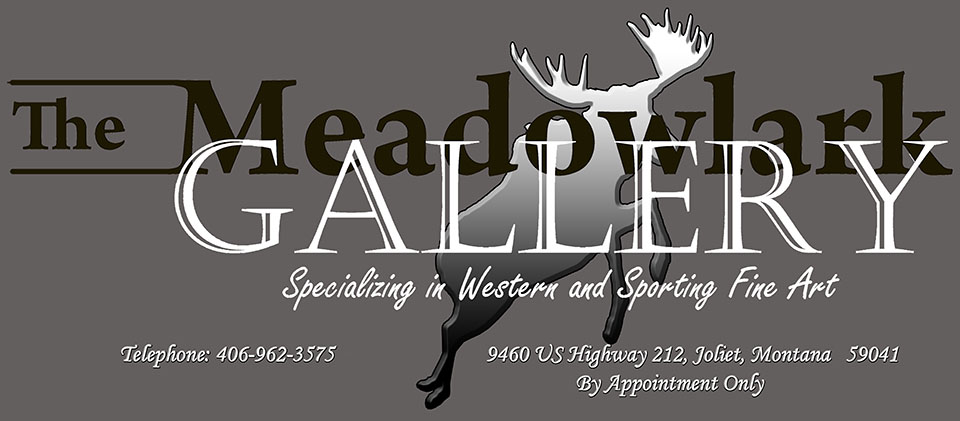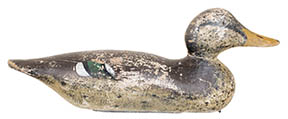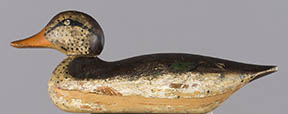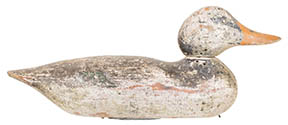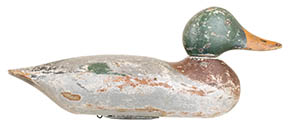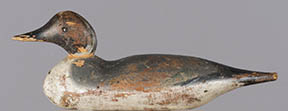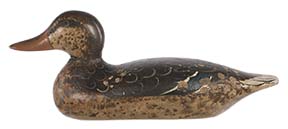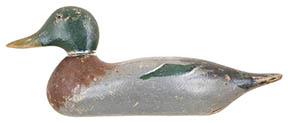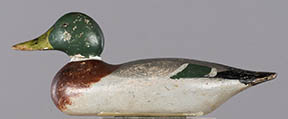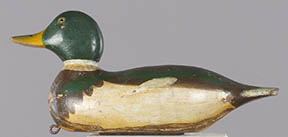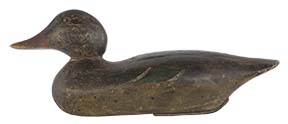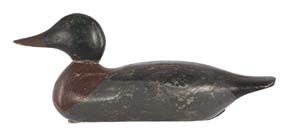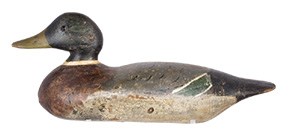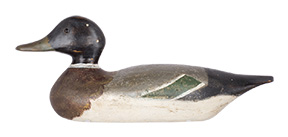|
|
||
|
A Decoy Remembered by Gary L. Temple |
||
Introduction The old double barrel shotgun did not look like much, but to me, it was the ultimate. I believe it was a Stevens 311A twelve gauge shotgun. My father showed me a dent in the barrel. My grandfather had confiscated it when he was the Beaverhead County Sheriff in 1948. This shotgun to others may have not looked like much but it carried the characteristics I still enjoy today. It had double triggers and side-by-side barrels. Sadly it developed a malfunction where it had to go down the road with deep regrets. My father felt duck hunting was a waste of time for the limits were much lower in the 1960’s than they had been in the 1940s. I had a school chum who took me out to a lake in the valley. There were several canals running into it. The word was it had been an old sewage lake for the town of Helena. The lake still was good for duck hunting and I can remember my first outing. Unfortunately for a brownish duck who at the time I could not even identify his swimming up the ditch ended. It went home to my mother who showed me how to pick it and I believe we cooked it and survived. My earliest memories of duck decoys came from reading a Herter’s catalog. The reader became totally immersed on the recommendations of decoy spread placements. They avidly recommended a Mallard spread of about one hundred birds, followed by fifty to sixty goose decoys with the addition of confidence decoys such as coots. Unfortunately for me as the young reader the numbers and costs were way over my head. One day at the local drug store I noticed they had decoys for sale. The economics were still against me until the store owner noticed the lack of sales. Finally they dropped the price to about eleven or twelve dollars so my parents allowed me to buy one box of a dozen. The next week the drug store dropped the price again to just over five dollars per box but my parents felt I had enough decoys. Little would they know how my interest in decoys had just begun. As a young person in my teens I soon learned about decoy placement, numbers of decoys and the use of confidence decoying. On the smaller waters and inlets showed the need for not a lot of decoys but good placement. My memory of placing decoys out in the dark with my trusty flashlight was always an eye opener. The lessons included while placing decoys in the dark of just kicking the water and having teal land within inches of my feet. Waterfowl hunting will always be a special place in my heart.
The Beginning Edward Mason was a professor of agriculture at the University of Dublin in Ireland.(1) He decided to come to the United States with his wife and five children. Edward Mason was an accountant from 1855 to 1861 and became the agriculture editor of the Detroit Tribune.(2) William J. Mason was one of four sons and had a strong interest in the hunting and fishing like his father. William J. Mason was an avid sportsman and became a member of the Old Club on Harsens Island in the St. Clair River delta area. He was reported to also be one of the top shots in the club.(3) In a little shed behind his parents home at 49 Tuscola Street, he started making decoys.(4) From a 1913 ad it indicated the company was established in 1889.(5) By 1872, William J. Mason was listed as a clerk in the John E. Long Sporting Goods Company of 133 Jefferson Avenue.(6) The W. J. Mason Company by 1882 had reorganized the business location.(7) The W. J. Mason Company consisted of the partnership of William J. Mason and George E. Avery. The business moved in 1888 to Woodward Avenue but the partnership dissolved.(8) Two grades of decoys were produced by William J. Mason from his early days of carving decoys. The Premier Grade was a little larger with a notch on the top of the bill, flat bottom and a hollow or solid body. The notch was characteristic of a Mason decoy. The Challenge Grade was offered as a solid or hollow body with a rounded base with an inscribed line between the bill and the face but no notch.
Old duck hunters never die, they just smell that way. One morning I decided to grab a small bag of decoys to check out a new site for a possible blind. I had assumed the bag contained mallard decoys. After walking a good distance, I reached into the bag to put out the decoys and realized they were actually teal decoys which were much smaller. Not wanting to go back I put out the teal decoys and decided to just watch. After a little bit, to my amazement I heard some geese calling. I looked up to watch the geese turn into the decoys.
There are two views of the Masons Decoy Factory, one which was around 1900. The duck hunting scenario of 1900 was split between those of the commercial hunters and the hunting as a personal choice. Sadly in 1900, duck hunting on a commercial basis soon caused the need for waterfowl hunting regulations. The second view is of the collector primarily today but there are still stories of finding wood decoys in a duck hunter’s rig. Sometimes the basic knowledge about decoys is simply of it being a toll for duck hunting and not collectibility. The Masons Decoy Factory was moved in 1903.(9) At this location of 456 Brooklyn Avenue, William J. Mason installed tracing lathes to produced the bodies and rough turn out the heads which then were finished by hand.(10) There were two additional men where one concentrated on the painting of the decoys and the other split cedar logs into blocks. With the increase in mail orders, William J. Mason also leased a rear two story space from the Nicholson Lumber Company at 456-464 Brooklyn Avenue.
The building was small and had two floors. The lathes, band saw and sander were downstairs, while upstairs the painting and packing was done.(11)
Wagons brought in the cedar logs which were then cut into workable lengths. Patterns were used when cutting the bodies on the lathes. Heads were rough-turned and sanded later. Before taking the decoys upstairs in crates, the head and body were joined. Upstairs there were three benches with an apprentice and a senior painter at each bench. Drying racks were on each side of the painters. In addition, this is where the puttyers did their work. They filled in around the necks of the Standard Grade decoys with white putty. The fit of the head and body on these grades wasn’t perfect, so the putty gave the neck a smooth look. The apprentices put on the primer coat of white lead, linseed oil, and turpentine after the puttying was done and put them on the racks to dry. The senior painter first painted the body with the correct plumage, let it dry, and then painted the head. The glass eyes were added last. Before insertion, the eyes were painted on the back. On hollow-bodied Premier and Challenge models, white lead sealed the two body parts before being nailed together. When the decoys were completely finished, they were balanced by floating them in a wash tub and adding the lead weight. All decoys were wrapped separately in newspaper and packed by the dozen in wooden crates. The Premiers had the newspaper they were wrapped in coated with linseed oil. This kept the paper from sticking to the paint. A horse and wagon picked the crates up at the factory.(12) These reflections of the shop were from an apprentice painter who worked there from 1904 to 1906. The employees worked six ten hour days a week for a dollar a day. There was no vacation time or sick leave.(13) All of the lathe turned Mason decoys have been assumed to have been made after 1903 while all of the hand shaped ones were done pre-1903. Russ Goldberger and I visited over the telephone about the production of the Masons Decoy Factory. Conceivably the production could have been about two hundred thousand decoys. Russ did not have a feel for why or why not certain models were purchased in the 1900s. Today on the collecting market the appeal for certain models is based upon new factors different from hunting. He went on further to talk about the sensual lines of the Premier and Challenge Grades.(14) Now I am not disputing the comments of Russ but decoys to the duck hunter are one of the various tools in their arsenal. Duck decoys can be traced back to Egyptian times where waterfowl decoys were used on the Nile River. Native Americans in North America used primitive decoys long before the white man. The Lovelock Cave(15) was conducive to the preservation of organic and inorganic material. Beings have occupied this area for over 4,000 years. In 1911, a fertilizer company hired two miners, David Pugh and James Hart, to search for bat guano to be used for fertilizer. They had taken out a top layer which weighed about 250 tons. The miners had found some artifacts but without a lot of significance. An archaeologist, L. L. Loud, in 1912 collected about 10,000 material remains without any comprehensive reporting.
In 1969, they dated the decoys with an accelerator mass spectrometry dating technique. The two decoys used were dated at 2,080 and 2,250 BP (before physics). Before physics(16) refers to the time before nuclear weapons testing artificially altered the proportion of the carbon isotopes in the atmosphere, making dating after that time likely to be unreliable. The commercial waterfowl hunters in the 1800s were concerned with putting out the most decoys possible for the result was beneficial to the harvest. I am sure costs and portability of wood decoys became a real variable during this period. William J. Mason died from rheumatic fever on November 29, 1905.(17) At the time of his death, the Masons Decoy Factory only produced the Premier and Challenge grades.(18) Herbert W. Mason was the son of William J. Mason and had done the clerical work of the factory.(19) Herbert moved the factory again and continued the business until 1924.(20) The Standard Grade model was developed by Herbert.(21) The Standard Grade or Detroit Standard Grade was a solid body, rounded and offered in three styles. The styles or grades were titled as No. 1 Glasseye, No. 2 Tackeye, and No. 3 Painted Eye. The basic pricing in 1905(22) was as follows: Herbert W. Mason developed during his tenure a strong mail order market. The Mason company became a volume supplier to Sears Roebuck. Another major supplier was Von Lengercke and Antoine of Chicago which was later acquired by Abercrombie and Fitch.(23) The introduction of the three types of the Standard Grade also included lower pricing for the market.(24) With the above price structure of the Standard Grades discounted at over half to a third of the Premier and Challenge Grades it was an easy decision for the hunter. Another move was made to 5935 Milford, Detroit, Michigan.(25) As the business continued to improve another move was made to the final location of 5971-5975 Milford Street.(26) The business of building decoys and wooden spokes had still been a seasonal one.(27) Herbert W. Mason and a friend, Fred W. Rinshed, was a paint salesman.(28) They were informed of the Ford Motor Company wanting to buy paint direct from a manufacturer.(29) After hiring a chemist, the two men jumped into the unknown industry under the name of Rinshed-Mason Company in 1919(30) became the largest outside paint supplier to the Ford Motor Company. Joseph R. Mason was another son of Herbert W. Mason who recalled, As a young fellow I remember the overhead belt lines and banks of wood lathes. The decoy bodies were turned on the lathes, using a model to trace from. The heads were hand made. All were hand painted, with conventional paint. In spite of some opinion to the contrary, there was nothing special about the paint, and it was pure coincidence that my father got into the paint business. It was not because he needed it for the decoys.(31) Eventually the decoy area of the factory disappeared up into the attic above the paint laboratory prior to World War II. After World War II,(32) the attic was empty. As paint manufacturing took over the old duck shop, fine Premiers were used to hammer down the lids of five gallon paint cans. Others were put in trash cans and sent to the dump for incineration.(33) And as was the case ... the Ford Motor Company had a better idea. ______________________ (1) Mason Decoys Byron Cheever; Hillcrest Publications, Spanish Fork, Utah; 1974, page 5. Bibliography Factory Decoys of Mason, Stevens, Dodge, and Peterson by John and Shirley Delph; Schiffer Publishing Limited, Exton, Pennsylvania; 1980. https://en.wikipedia.org/wiki/Lovelock_Cave Mason Decoys by Byron Cheever; Hillcrest Publications, Spanish Fork, Utah; 1974. Mason Decoys, A Complete Pictorial Guide, Updated Edition by Russ J. Goldberger and Alan G. Haid; Decoy Magazine, Lewes, Delaware, 2014. Telephone interview with Russ Goldberger. Russ and Karen Goldberger have RJG Antiques in Rye, New Hampshire. Waterfowl Decoys of Michigan and the Lake St. Clair Region, collected and edited by Clune Walsh, Jr., and Lowell G. Jackson; Gale Graphics, Detroit, Michigan, 1983. |
||
|
View high resolution images of works by Mason's
Decoy Factory when available.
|
||
Have questions about these images? E-mail Meadowlark Gallery!!Biography Library / Bronze / Collectibles / Etchings / Paintings / Pen and Ink / Graphite / Working Decoys Gallery Credentials / Firearms / Triangle Z Ranch Furniture / Customer Percs |
||
